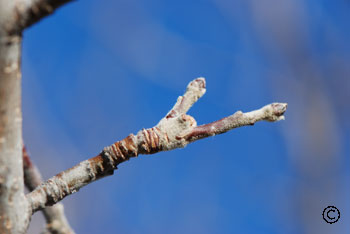Tree vigor is a crucial concept in horticulture that refers to the amount of shoot growth a tree exhibits in a given year. Recognizing the distinction between the current year’s growth and the previous year’s can help you make informed pruning decisions. This distinction is marked by a noticeable ring or ridge on the branch, indicating where this year’s growth begins. For instance, on a cherry branch, the newer shoot will have lateral flower buds, while the older section will display spurs with flower buds.
To maintain a healthy balance between shoot growth and fruiting, it is essential to understand how tree vigor impacts pruning practices. Vigorous shoots, which grow two feet or more in a year, are less likely to produce flower buds in the following season. Conversely, shoots that grow less than four inches are known as spurs; these cease growing earlier in the summer and begin forming buds that will yield flowers and fruit the next year. Ideally, a fruit tree should exhibit a mix of spurs and shoots measuring one to two feet in length for optimal fruit production.
When assessing a tree’s vigor, remember that a tree with predominantly strong shoots may require light pruning to avoid overstimulating growth. On the other hand, a tree with an abundance of spurs may lack vigor and will not benefit from aggressive pruning. Vigorous trees tend to form fewer flower buds, so careful consideration should be given when pruning to avoid removing too many potential blooms. In contrast, weak trees with excessive flower buds may benefit from selective pruning to restore balance between flowering and shoot growth.
Flower buds are formed during the previous season, typically in summer, and continue to develop through fall and winter. In spring, these buds bloom, produce fruit, and generate new shoots or spurs, perpetuating the cycle. In apple and pear trees, flower buds are located at the tips of short shoots and spurs, characterized by their swollen bases and larger size compared to leaf buds. Shoots that form terminal buds in late spring or early summer have more time to develop into flower buds, while those that continue to grow into late summer are more likely to remain leaf buds.
Pruning decisions are essential for maintaining tree health and aesthetics. Begin by examining the tree from various angles to identify crowded areas, dead branches, and overall shape. Focus on removing excess growth while preserving healthy branches. Dead branches can be eliminated with thinning cuts, while heading cuts may be used for partially dead branches.
When assessing the tree’s size and shape, determine if it is too tall or wide. Use thinning cuts to remove overly long branches and maintain a desirable height. It’s best to avoid over-pruning in any given year; if the tree has not been pruned recently, prioritize which limbs to remove based on their productivity and flower bud abundance.
Consider the density of the tree’s growth as well. Ensure that each limb has enough space for side branches and that sunlight penetrates to lower branches. If branches are too close together, thinning cuts can help alleviate overcrowding. The amount you prune should depend on the tree’s vigor; for vigorous trees, remove one or two large branches at a time, while less vigorous trees can handle more extensive pruning.
Finally, pay attention to the angle at which branches grow. Weak branches that point downward or watersprouts that grow straight up are usually unproductive and should be removed. Keeping branches that grow at a more favorable angle will encourage a healthier, fruit-bearing tree.
By understanding tree vigor and making informed pruning decisions, you can foster healthy growth and abundant fruit production in your trees. Happy pruning! 🌼🌿

